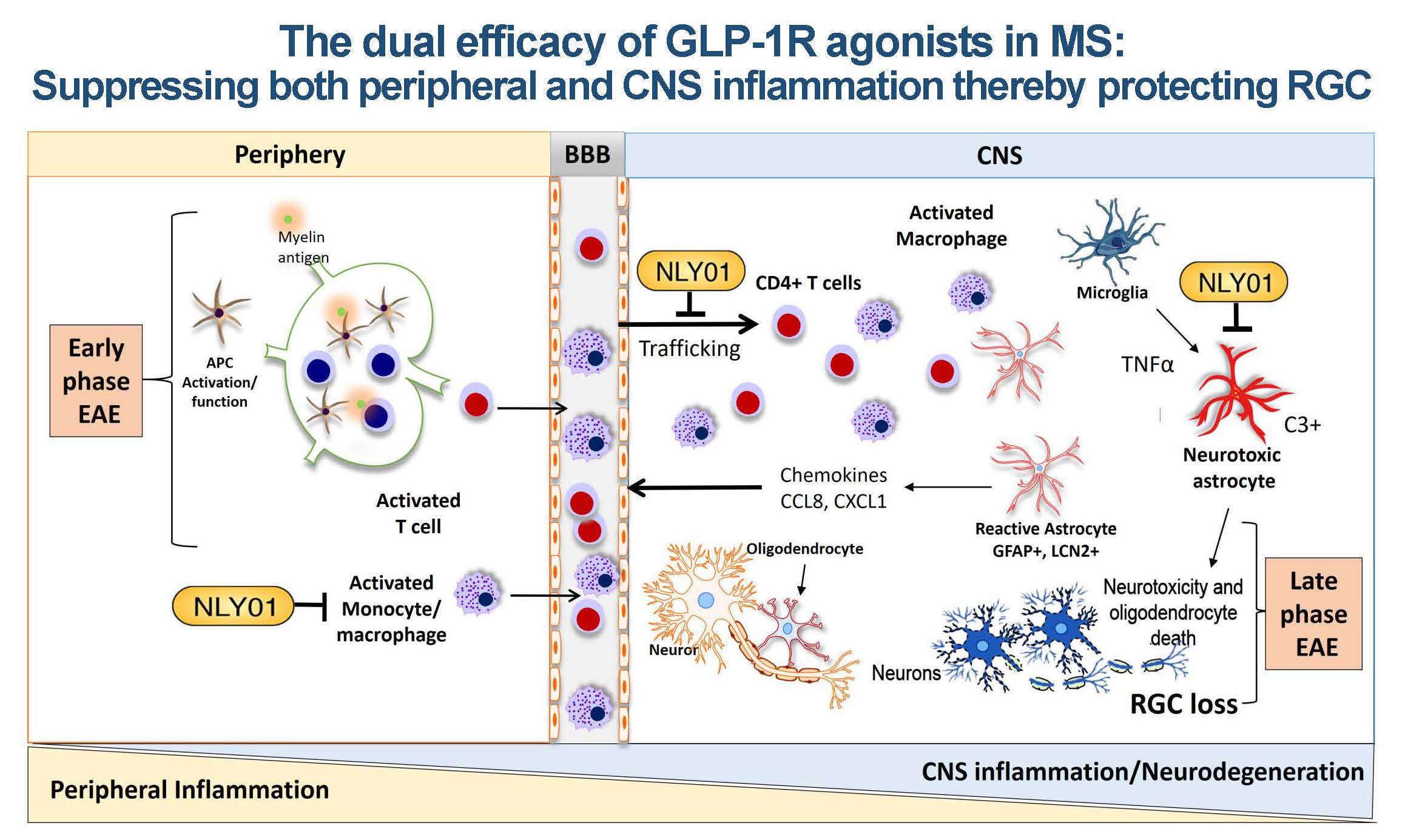Multiple Sclerosis
Glucagon-Like Peptide-1 Receptor Agonist as New Therapeutics for Multiple Sclerosis



Posted January 30, 2024
Dr. Peter A. Calabresi, Johns Hopkins University
 Dr. Peter A. Calabresi
Dr. Peter A. Calabresi (Photo Provided)
Multiple sclerosis is a chronic autoimmune disease that affects the central nervous system, causing problems with nerve cells and leading to symptoms, such as numbness, tingling, motor deficit, depression, fatigue, visual loss, and cognitive dysfunction.1 MS causes the breakdown of the protective layer of tissue surrounding nerve cells called the myelin sheath. This process, known as demyelination, results in nerve cell damage.
Current disease-modifying treatments on the market focus on suppressing the immune attack to the central nervous system. No therapies directly target nerve damage caused by MS. A recent study from Johns Hopkins School of Medicine shows that a molecule called NLY01, which can cross the blood-brain barrier, BBB, and enter the brain, is helpful in protecting nerve cells in mouse models of Parkinson's disease.2,3 NLY01 works on a receptor called Glucagon-like peptide 1 receptor, GLP 1R. This receptor is important for regulating insulin. The potential for NLY01 to protect the myelin sheath in the context of MS is unknown.
With an FY18 Multiple Sclerosis Research Program Investigator-Initiated Research Award, Dr. Peter Calabresi and his research team at Johns Hopkins University investigated whether NLY01 could treat multiple sclerosis. This trial used two animal models of MS: the experimental autoimmune encephalomyelitis, EAE, model to mimic the autoimmune response and neurodegeneration in MS and the cuprizone, CPZ, model to mimic demyelination to nerve cells and to study remyelination of the damaged nerve cells in MS.
The investigators first determined the presence of GLP-1R in mature oligodendrocyte cells in the CNS. These cells are responsible for producing and maintaining the myelin sheath of nerve cells so the GLP-1R agonists, like NLY01, would target mature oligodendrocytes. In a prevention trial using the EAE model, when researchers gave mice NLY01 at the time of EAE induction, they observed that NLY01 significantly delayed the onset of the disease and reduced disease severity.4 NLY01 showed anti-inflammatory effects by inhibiting the activation of immune cells in the spleen and preventing the trafficking of activated immune cells into the CNS. In a treatment trial, researchers gave NLY01 to mice with EAE symptoms. They observed a significant reduction in clinical scores and secondary attacks, as well as protection of neurons in the retina.
In the CPZ model, researchers gave mice NLY01 at the beginning of CPZ induction. The team found demyelination significantly decreased compared to the control. When researchers gave mice NLY01 on day 12 after CPZ induction, they observed more regrowth, or remyelination, in the treated mice compared to the control group. The team also noted that mice in the NLY01-treated group lost weight, which was expected because NLY01 reduces appetite.5 But, when CPZ doses were properly controlled, the NLY01 was no longer effective in reducing demyelination or improving remyelination.
This study demonstrated that the long-acting GLP-1R agonist, NLY01, has different health benefits in two different mouse models of MS. The anti-inflammatory and neuroprotective effects of NLY01 in EAE models and potential benefits of calorie restriction on MS from other studies warrant further research on GLP-1R agonists as a new therapeutic for multiple sclerosis.
 Figure 1 illustrates the putative anti-inflammatory and neuroprotective effects of GLP-1R agonists in MS. NLY01 may have dual efficacy in MS by suppressing both peripheral and CNS inflammation, thereby limiting neuronal loss. (Figure taken from Gharagozloo, M, et al.4)
Figure 1 illustrates the putative anti-inflammatory and neuroprotective effects of GLP-1R agonists in MS. NLY01 may have dual efficacy in MS by suppressing both peripheral and CNS inflammation, thereby limiting neuronal loss. (Figure taken from Gharagozloo, M, et al.4)
References:
1https://www.ninds.nih.gov/health-information/disorders/multiple-sclerosis
2Yun SP, Kam TI, Panicker N, et al. 2018. Block of A1 astrocyte conversion by microglia is neuroprotective in models of Parkinson's disease. Nat. Med. 24(7):931-938.
3Park JS, Kam TI, Lee S, et al. 2021. Blocking microglial activation of reactive astrocytes is neuroprotective in models of Alzheimer's disease. Acta Neuropathologica Communications 9(1):78. doi: 10.1186/s40478-021-01180-z. PMID: 33902708; PMCID: PMC8074239.
4Gharagozloo M, Smith MD, Sotirchos ES, et al. 2021. Therapeutic potential of a novel glucagon-like peptide-1 receptor agonist, NLY01, in experimental autoimmune encephalomyelitis. Neurotherapeutics 18(3):1834-1848. doi: 10.1007/s13311-021-01088-5. Epub 2021 Jul 14. PMID: 34260042; PMCID: PMC8608955.
5Gharagozloo, M, Galleguillos D, Jank L, et al. 2023. The Effects of NLY01, a Novel Glucagon-Like Peptide-1 Receptor Agonist, on Cuprizone-Induced Demyelination and Remyelination: Challenges and Future Perspectives. Neurotherapeutics 20(4):1229-1240. doi: 10.1007/s13311-023-01390-4. Epub 2023 Jun 9. PMID: 37296356.
Last updated Monday, March 10, 2025














